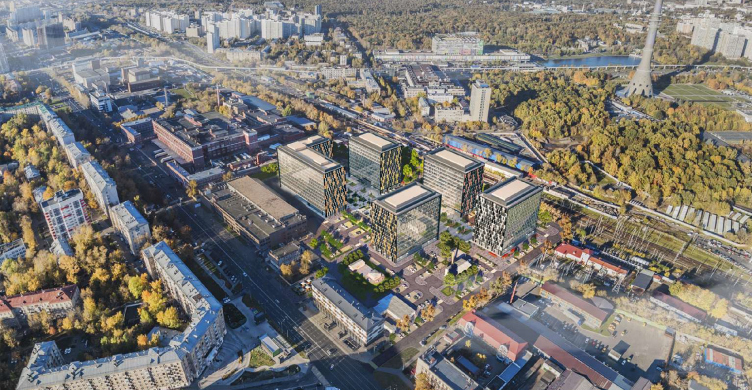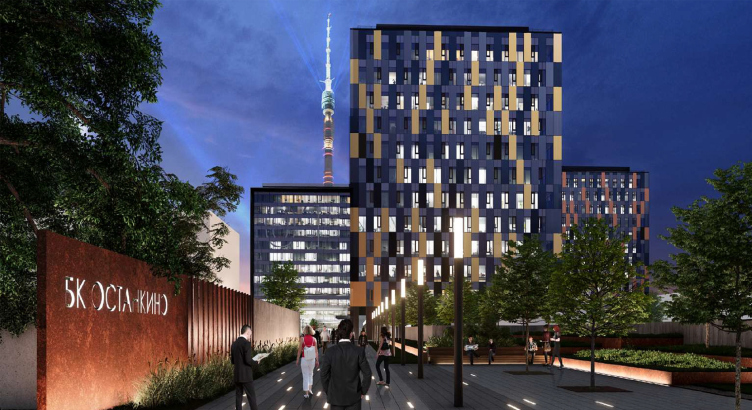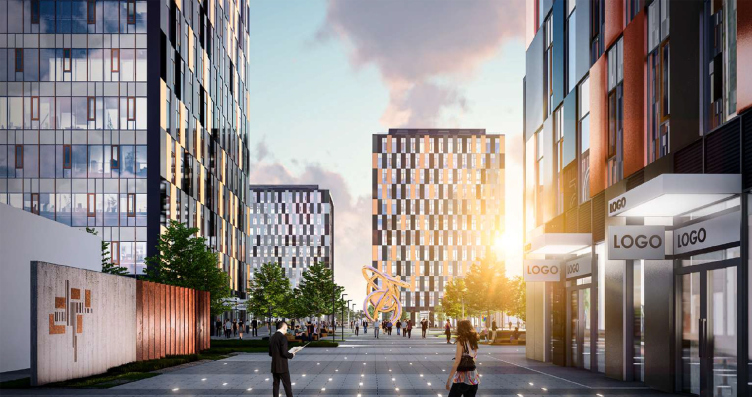Ostankino Business Park
Copyright: © UNK Group
Due to the fact that in 2016, nearby, at the crossing of the Ogorodny Drive and the Rustaveli Street, a new metro station “Butyrskaya” opened, the transport accessibility of the site is excellent. Today, along the fence of the former cold storage facility, there is quite lively interchange traffic: people go both from the metro to the platform and in the opposite direction too. However, the space of the pedestrian flow is not organized in any way yet, and its organization became one of the key subjects of the design process – after the project is implemented, the main pedestrian path will no longer circle the territory but will go through it, diagonally from one station to the other.
Today, people who go through that place have to walk through endless fences and piles of debri, but they will walk, according to our plan, through a cool and fashionable square, packed with cafes, shops, and events. It will be a safe and beautiful place, with a lot of activities going on along the way. We organized a pedestrian square and proposed different scenarios for its use – a skating rink, a concert venue, and a Christmas tree that will be installed there in winter. Such a solution, a city mini-center, can be seen in the “White Square” business center on Belorusskaya, and we hope that the Ostankino Business Park will play a similar role in the life of Butyrskaya area.
The office buildings are placed in a freehand fashion – they gravitate towards the outside contour but do not form a specific front of any of the streets. The volumetric composition of the complex serves two tasks: to vacate space for the pedestrians in its central part and open up the passages, even “pulling in” the pedestrian flows. The overland parking lots are grouped closer to the outer borders of the territory (the largest is at the railway station) and vacate the center, which will be vehicle-free. A lot of attention has been paid to the improvement of public space; plans for its implementation are divided into 3 stages, and the central part and transit routes should appear at the first stage of the construction of the business park.
The pedestrian space inside the complex stretches parallel to the Ogorodny Drive, from southeast to northwest, and is delicately zoned by green islets, lawns, paving patterns, and geo-plastics. The two main entrances to the territory of the complex are turned, one to the Ogorodny Drive (in the direction of the closest metro station entrance), the other to the Rustaveli Street and the “Zelenaya Arka” shopping mall, the only mall in this area. On the inside, the transient routes are placed in a crosswise fashion, allowing you to freely traverse the territory in any of the main directions.
In the lighting project, the street lights are reinforced with backlighting installed into the pavement – in addition to its purely aesthetic function, it shows the main direction of the transient movement – people will walk along the glowing strokes.
Ostankino Business Park. The entrance group from the side of the Ogorodny Drive
Copyright: © UNK Group
The paths come together in the center of the pedestrian space, which the authors themselves define as the attractor: it is here that there will be a few concert venues and a skating rink, and a sculpture will also be installed – a compositional and contextual accent, emphasizing the status of this place specifically as a city square (because squares usually feature sculptures, columns, or obelisks).
Ostankino Business Park. The entrance group from the side of the Rustavely Street
Copyright: © UNK Group
The space on either side of the transient paths is interpreted as the “zones of moderate traffic” with benches and landscaping inclusions. These “zones of moderate traffic” are overlooked by the summer terraces of the restaurants – they are designed for more than 300 seats, which is quite a lot, and must further contribute to creating a rather cozy atmosphere in the spirit of the “centers of European towns”: in the historical center of Moscow such places are already quite numerous, while the peripheral areas, starting from the Third Transport Ring and further away, still lacks such local hangouts.
The west building is adjoined by a boulevard – a “quiet zone”, which is not paved, as the rest of the complex, but has a lawn with boardwalks running through it. According to the architects, the coverage is 1.2m thick, and the man-made hills are enough to plant mid-size trees in them. The architects propose two options for geo-plastics: traditional, in the form of streamlined “islands”, and more energetic in form, in which the artificial hills are cut into volumetric “stripes” within the boundaries of the vertical walls.
Thus, the complex is designed to create a developed and landscaped city space – relatively small, yet safe, supporting among other things, the transit function, and packed with other useful features. Virtually all of the bottom floors are occupied by various kinds of retail businesses – two restaurants, a café, cafeterias, a small supermarket, and other stores are grouped on either side of the double-height lobbies. The height of the bottom floors is 5.4m, the main office ones 3.9m.
An important detail: the glazing of the bottom floor is of the floor-to-ceiling type, and the floors will be on a level with the pavement of the plaza – the cafes, restaurants, and their terraces will be connected not just visually but emotionally as well. All of this will be open 24/7, and the fact that this complex is in fact a part of a small transportation hub will ensure good visitor traffic and good return on investment for the city infrastructure.
There is no underground car park in the project – the buildings will only have technical basement floors underneath them, all the car parks being overland.
It is expected that the five 12-story buildings of the business park will be constructed in three phases. However, the beginning of each next stage is scheduled no later than six month after the completion of the preceding one, so that the renters would not have to live next to a construction site for too long – the architects explain.
The layouts and the facades of the buildings are subjugated to the requirement of efficiency and pragmatism – they ensure both diverse options of lots, and an opportunity to quickly add more floor space for growing companies.
The office facilities are grouped around the communication core; the elongated facades are completely made of glass. The open-able windows form a freehand pattern, close to a checkerboard one. On the side-end facades, glass alternates with panels of metallic hue, and, although the alternation is regular, the picturesque “pixel” coloring livens up the rhythm. The glass facades are encased in a volumetric frame, very much like a “television”, which display in large figures – 4 floors high – the numbers of the buildings. It is planned to use glass with a reflectivity of at least 10%, so that the stained glass panes will probably reflect the sky from some angles.
Ostankino Business Park. The zone of moderate traffic
Copyright: © UNK Group
The panoramic stained glass windows of the facades are a natural solution for modern office buildings that must allow natural light to penetrate as deep inside of them as possible. The windows will command sweeping views, which are already advertised at the business park’s official website. The panoramas here are indeed beautiful, especially the “postcard” view of the Dubovaya Roshcha park and the Ostankino TV tower.
The design of the lobby and the public part of the interiors, proposed by UNK Project, is also reservedly laconic: the prevalent white color of the walls and the ceiling is contrasted by rich wine red and neutral gray.
According to the authors of the project, it is designed to ultimately get a BREEAM certificate – of course, it may seem that it’s a little bit premature to speak about that while still in the concept stage, but in reality this is when the preparation of a “green” complex must begin. To ensure the sustainability of the complex, the authors are proposing to use: energy-efficient lights and climate control devices, collection of “gray” water, energy-saving glass on the facades, and the absorption of heat emitted by the buildings by the green plants on the territory of the complex.
***
The area of the Butyrskaya metro station, called after the village of Butyrsky (not to be confused with the settlement of Butyskaya) is actively changing with the appearance of the new metro station. At the same time, you cannot say that the changes are taking place at a mind-blowing rate. As before, the place is generally known for the production of sausage, ice-cream and cheese, and the Ogorodny Drive still predominantly consists of shabby-looking fences. A new shopping mall and a few cafes have appeared; a small theater has long been functioning. A few years ago, upon the project by Yuri Grigoryan, the Goncharovsky Park, lying west of Rustaveli Street, was reorganized. The “post-Stalin” city blocks border on industrial estates, and this place still feels better if you drive, rather than walk through it. The emergence of the Ostankinsky business park on the way between the two stations, the railway and the metro, can work in such a situation as a catalyst – a trigger for the “restart” of the territory, a creative and fashionable place for meetings, communication and events, with a developed functional program and thought-out environment.
One must note two more things. First, in this day and age, projects of office complexes that are not mixed with the prevailing housing, but independent are a rather rare thing, which is worthy of attention And second – just see how noticeably the approach to the development of areas of future construction has changed over the past 10 years: instead of fences and guards at the checkpoint, there is a city square that seeks to attract, and not scare away the city people, and to let the maximum flow of visitors through itself. This approach, of course, is not exactly groundbreaking, but it’s a good thing that it is practiced more and more often.























































